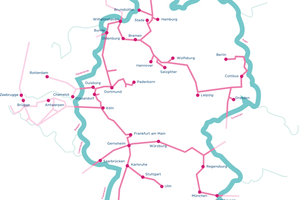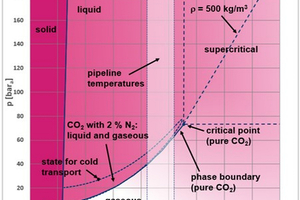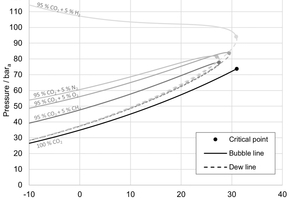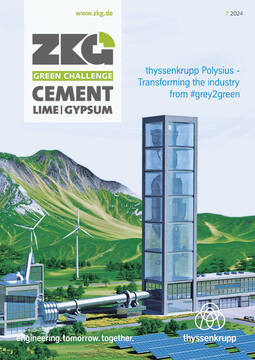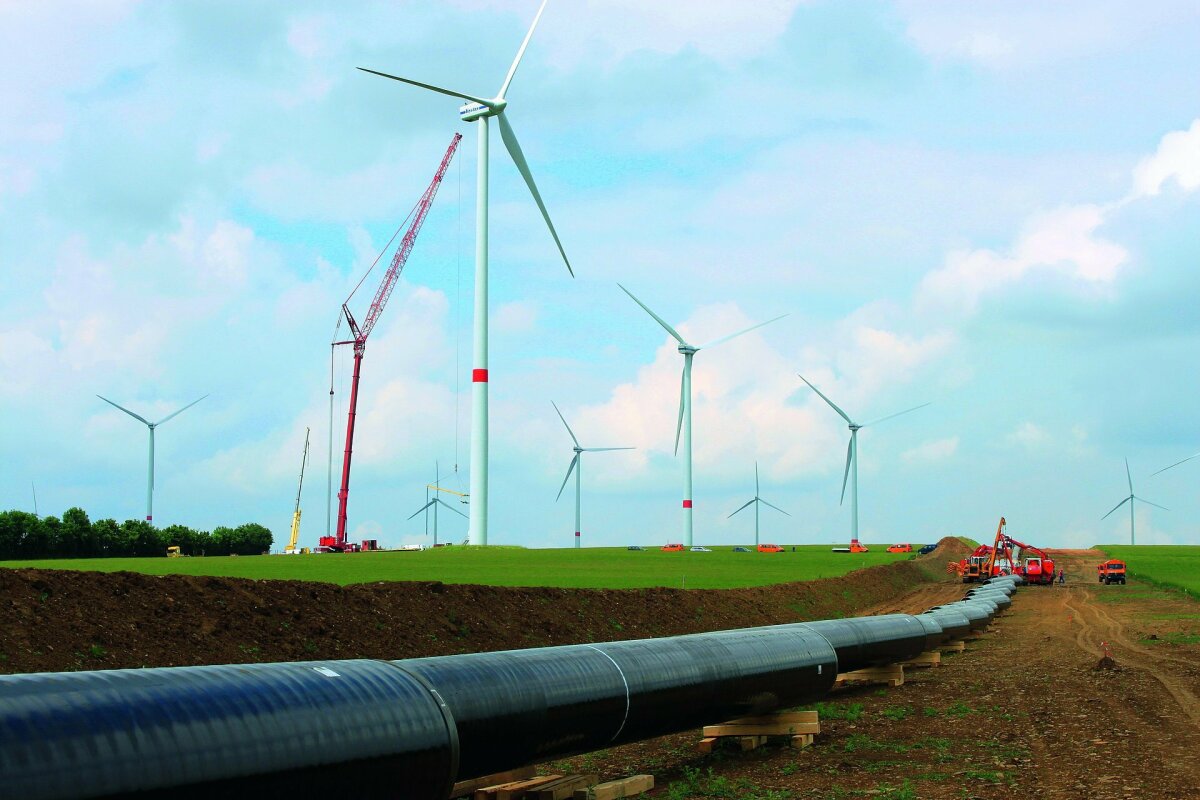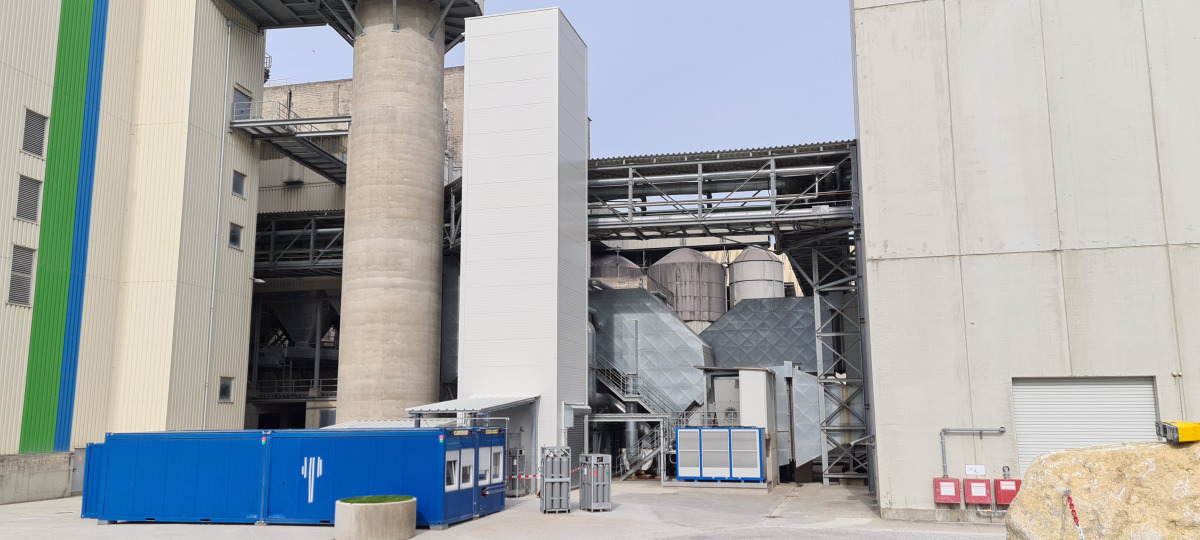CO2 pipeline infrastructure for Germany
Introduction
The European Union has set the goal of becoming climate neutral by 2050, with an interim target of reducing net greenhouse gas emissions by at least 55% by 2030 compared to 1990. Germany has anchored similar goals in the Climate Protection Act, which aims for greenhouse gas neutrality by 2045 and seeks to reduce emissions by 65% by 2030 compared to 1990.
The most important technologies for achieving these ambitious goals include renewable electricity sources such as wind and solar, which are becoming increasingly competitive with fossil fuels. In addition, battery technologies and hydrogen as a climate friendly energy carrier are of great importance. However, despite all efforts to reduce greenhouse gas emissions, there are certain industry sectors where carbon dioxide (CO2) emissions cannot be avoided even when the most advanced technologies and processes are applied.
The most prominent examples of this are the cement and lime industries and waste incineration, where fossil or geological CO2 emissions are mainly caused by the underlying physical or chemical process. Consequently, these unavoidable emissions must be effectively captured, transported, and either stored or utilized in order to reach the climate goals. Even though various methods, including pre-combustion, post-combustion, and oxy-fuel combustion techniques for CO2 capture are already state of the art, there are still no large-scale CO2 transportation systems available in Europe by now. However, studies such as those conducted by the German Cement Association (VDZ) (VDZ, 2024), show that for the cement, lime, and waste incineration industries, the development of a CO2 infrastructure is essential. According to their study, the annual CO2 emissions from these three sectors alone are estimated at around 58-65 million t/a (Mt/a) in Germany. Thus, the VDZ emphasizes that without a transport infrastructure, climate neutrality by 2045 cannot be achieved and that a CO2 pipeline network is necessary by 2035 at the latest to meet the climate goals.
To support the initiative of becoming a climate neutral economy and thus contribute to strengthening the competitiveness of German industry, Open Grid Europe GmbH (OGE) plans a CO2 pipeline infrastructure for Germany. As shown in Figure 1, OGE’s CO2 grid is based on demand-oriented planning, connecting emission-intensive regions and enabling cross-border transport. However, developing a CO2 transport infrastructure is also associated with various challenges, ranging from technical and commercial implementation to political support and public acceptance, which are outlined in more detail in this article.
Who is OGE?
OGE is one of the leading gas Transmission System Operators (TSO) in Europe and can look back on over 90 years of company history and expertise. Today, OGE operates a natural gas pipeline network of around 12000 km and will now realize significant growth in hydrogen transport with the implementation of the German H2 core grid.
As a company, OGE has always accompanied the transformation of the energy supply and actively promoted the associated changes, starting with the development and establishment of city gas networks, the changeover to natural gas and the current step into the world of hydrogen. OGE is a reliable partner for business, politics and the public, as we were recently able to prove again in 2022 when the WAL (Wilhelmshaven Connection Line) to connect the first German LNG terminal was built at record speed.
Another chapter in this story is now being written by enabling the future transport of CO2. OGE is currently collaborating with various international partners and is working on the implementation of the first CO2 infrastructures. These efforts include the projects Elbe Cluster, WHVCO2logne, Delta Rhine Corridor and North Sea CO2 Corridor.
Legal framework (from the German perspective)
In February 2024, the EU Commission presented a Industrial Carbon Management Strategy (ICMS). The strategy is part of a package of measures aimed at achieving “net zero” CO2 emissions by 2050. At the beginning of the year, the EU Commission also announced a ‘CO2 transport and storage regulatory package’ that is intended to address the issues of regulation, among other things. At EU level, a target is set for the development of capacities for the geological storage of CO2. The aim is to achieve at least 50 Mt/a of CO2 by 2030. In addition, the European Commission proposed the Net-Zero Industry Act (NZIA) on 16 March 2023. The NZIA is part of the Green Deal Industrial Plan for a predictable and simplified regulatory environment, which aims to promote investments that are crucial to achieving the EU’s climate neutrality targets.
In Germany the coalition agreement of the federal government between SPD, The Greens and the FDP states, in the chapter on ‘Transformation of the Economy’: “We acknowledge the necessity of technical negative emissions as well, and will develop a long-term strategy for dealing with the approximately five percent of unavoidable residual emissions.” In February 2024, the Federal Ministry for Economic Affairs and Climate Protection (BMWK) presented the key issues paper on a national CMS. The key points of the CMS include several areas, such as the development of a pipeline infrastructure for the transport of CO2, the offshore storage of CO2 in Germany and the promotion of CCS/CCU projects in order to ensure the competitiveness and climate neutrality of German industry. In February 2024, the BMWK published a draft amending the existing Carbon Dioxide Storage Act (KSpG). The new Carbon Dioxide Storage and Transport Act (KSpTG) is intended to provide the legal basis for the capture, transport and storage of CO2 (CCS) and the decarbonization of CO2 (CCU). Among other things, the draft contains measures to promote the use of CCS/CCU technologies, particularly in emission-intensive sectors with emissions that are difficult to avoid. A central aspect is the development of a pipeline infrastructure for the transport of CO2 in order to enable efficient and safe transport of the captured CO2 to the places where it is stored or utilized.
The federal state of North Rhine-Westphalia (NRW) is responsible for roughly 40% of Germany’s hard-to-abate emissions. In October 2021 the then state Ministry of Economic Affairs, Innovation, Digitalization and Energy already published a CMS, which addresses four areas of action: decarbonization, sustainable carbon use, CO2 management and social discourse. A crucial element of a climate-neutral industry in NRW is a circular carbon economy, along with holistic management of CO2 by means of capture, transportation, utilization and storage, since full decarbonization is not possible, the CMS states. The strategy also points out that a pipeline-based CO2 transport infrastructure is required due to the scale of emissions in NRW.
Regulation (e. g. tariff structure)
In the context of the development of the emerging CO2 market, the question of the regulatory framework is of particular interest from the perspective of a pipeline infrastructure operator. OGE currently operates a fully regulated natural gas transportation system. Fully regulated in this context means that both access to the network and the costs associated with its construction and operation are subject to regulation. The regulation of natural gas networks corresponds to the European standard model and is accompanied by so-called entry-and-exit systems or capacities. Regardless of the transportation distance, the same fee is always due within a control area. This is also known as the “poststamp” model. While comprehensive regulation has already been agreed on for hydrogen networks with various European interim solutions, the issue of CO2 is currently still completely open. Some see CO2 pipeline infrastructures more in the area of product pipelines due to the lower number of users and the overall lower number of pipeline kilometers. On the other hand, it is argued that a European transport system is being created here and that the number of users is significantly higher than for classic product pipelines, meaning that the operator of a corresponding pipeline has a stronger position.
The issues are discussed both at European level and at national level, in the case of OGE in Germany. In principle, the first question to be clarified is whether CO2 pipeline infrastructures will be subject to cost regulation in the short, medium or long term. This is because the question of access regulation is already clarified in the currently valid framework (KSpG) and also in its update (KSpTG). If the answer to the question “if” is yes, the question “when” must be answered. Will there be an unregulated transitional period or should the networks be subject to cost regulation from the outset? Both answers are an important signal to the market in terms of ensuring a stable legal framework and a certain degree of investment security. However, for a rapid market ramp-up or the rapid establishment of a nationwide CO2 infrastructure, for example, further questions must be answered independently of the first two questions, which become more urgent in particular in the event of full regulation. For example, how can early movers along the entire value chain be protected from prohibitively high fees? Which charging system should apply to transportation, should it be routes, zones or the aforementioned poststamp tariffs? What role will Carbon Direct Removal (CDR) measures play and who are the contacts and potential new customers? On the other hand, how can the value chains be developed on the scale required to offer the services at competitive prices? How can the investments be protected in the long term? Depending on the components, pipeline assets have lifetimes between 20 and 55 years. And all of this while taking into account and considering the competitive situation in which the various companies and sectors are competing at national, European and international level.
It quickly becomes clear that the challenge for companies in the development of CO2 value chains and thus also in the CO2 pipeline infrastructure is not small. The targets for all these activities are political and societal in nature, with climate neutrality in 2045 for Germany and 2050 for Europe, and therefore broad political support is essential in terms of the timeframe and especially with regard to the societal acceptance that must be in place.
CO2 pipeline transport
Pipelines are the most common and cost-effective method for transporting large volumes of CO2 over long distances. During transportation, it is necessarily always in impure form (“CO2 stream”). An important aspect in the planning of CO2 pipelines is thus the consideration of the allowable composition of the CO2 stream in order to avoid problems such as corrosion and fracture propagation. The ISO 27913 standard provides the basis for the design, construction and operation of CO2 pipelines, as it contains specific requirements and recommendations. In addition, DNV-RP-J202 provides guidelines for the design and operation of CO2 pipelines that address risks and uncertainties throughout the lifecycle of a CO2 pipeline, including design, testing, inspection, operation, maintenance and decommissioning. At national level, the German Technical and Scientific Association for Gas and Water (DVGW) has so far developed standards for CO2 quality (C 260), design and construction of CO2 pipelines (C 463), operation and maintenance (C 466) and plants in CO2 transmission systems (C 491). These standards do not formally replace but augment the existing G series of DVGW standards for natural gas infrastructure. More documents and further development will follow.
The challenges in the technical implementation of CO2 pipelines are manifold and require careful planning and construction. It is important that the pipelines are designed to meet the specific requirements of CO2 transportation while ensuring the safety and reliability of the system. An important aspect of the pipeline design is dictated by the state in which the CO2 is transported. In general, CO2 can be transported either in the gaseous, liquid or supercritical phase depending on the temperature and pressure of the system. In Figure 2, the state regions of pure CO2 are illustrated in a pressure-temperature diagram.
Furthermore, the term “dense phase” is often used in many regulations and literature. This term does not describe a distinct thermodynamic state but refers to a region in which the properties of the CO2 remain similar. Usually, “dense phase” refers to single-phase fluid CO2 and covers the liquid and supercritical region in which the density of CO2 is greater than 500 kg/m³. Above this value, pressurization practically does not involve compression, i.e. the CO2 stream can be pumped.
For pipeline transportation of CO2, the typical temperature range is between 0–50 °C. The upper temperature limit is determined by the properties of the external pipeline coating, while the lower limit is set to prevent ground frost. To avoid a phase change within the pipeline, the maximum operating pressure for transportation in the gas phase and the minimum operating pressure for transportation in the dense phase in this temperature range is thus determined by the saturation pressure of the CO2, which in turn is strongly dependent on the composition of the CO2 stream.
For transportation in the dense phase, the defined temperature range results in a minimum operating pressure of around 80 bar for typical CO2 compositions, while the maximum operating pressure is limited to 150 bar for reasons of flow assurance.
For gaseous transport, the lower temperature limit results in an operating pressure ranging from 20 – 33 bar to avoid two-phase flow. The flow velocity of gaseous CO2 may be restricted to 4–5 m/s to avoid temperatures falling below the frost threshold due to the Joule-Thomson effect. This effect describes the change in temperature of a fluid as it undergoes a pressure change. During pipeline transportation, the pressure of CO2 decreases over distance due to friction with the pipeline walls. This pressure reduction leads to an increase in the potential energy associated with intermolecular attractions as the gas expands, absorbing internal kinetic energy and thereby reducing the temperature. This cooling effect must be particularly considered in pipeline design of gaseous CO2, as the Joule-Thomson coefficient is significantly higher in the gas phase and almost negligible small in the dense phase. It is also significantly higher than for natural gas.
An important aspect of transporting CO2 in the dense phase is the avoidance of running ductile fractures (RDF). RDF refers to a type of catastrophic failure where an initial, sufficiently large fracture in a pipeline propagates along the pipeline at speed exceeding the decompression speed of the medium, splitting the pipeline over long distances until the geometry changes significantly, e.g. due to a valve, a different pipe diameter or wall thickness.
Identifying the required minimum fracture toughness of the material is an essential step in preventing such incidents. Furthermore, additional measures to arrest crack propagation might be considered to further guarantee the safety of the pipeline. The Battelle Two-Curve Method is an established approach for predicting the arrest of fractures in natural gas pipelines. However, the behavior of CO2 under decompression differs significantly from natural gas due to its phase transition from liquid to gas at relatively high pressures, which affects the pressure evolution during a fracture event. Numerous research institutes and transmission system operators including OGE are consequently pushing towards developing more accurate models that can predict the behavior of CO2 in the event of a fracture. These models aim to integrate structural dynamics with fluid and thermodynamics for a comprehensive understanding of running ductile fractures and the decompression behavior of CO2. Moreover, full-scale fracture propagation tests may be conducted to validate and refine these models, ensuring the safe and efficient operation of CO2 pipelines. For dense-phase CO2 pipelines, the wall thickness will usually be governed by the need to avoid RDF rather than the internal pressure, unless very high Maximum Operation Pressures are chosen.
CO2 quality
The standardization of CO2 quality is a prerequisite for the introduction of any transport system. The standardization process involves setting specifications for the purity and composition of CO2 to ensure safe and efficient transport. Currently, there is no universally agreed-upon specification for CO2 transport by pipeline. Instead, regulations require pipeline operators to make their own assessments and set entry requirement specifications accordingly. This has led to the development of many different specifications for each CCS project worldwide, ranging from a minimum CO2 purity level of 95% to close to 100% in cases where tank transport is involved, and with significant differences in allowed levels of other components.
Furthermore, many published specifications are still being developed and may be adjusted in the future. What all specifications have in common is that they are likely to be whitelists, i.e. substances without defined limit values must be below the detection limit of standard measuring instruments.
One of the major challenges of defining a national or international specification are the different sources of CO2. Depending on the upstream process, the CO2 streams can differ greatly in their composition and thus require different purification processes, which can be a major cost driver. Consequently, a standardized specification must both meet the technical requirements to ensure the integrity of the pipelines and represent the optimal cost for all market participants to ensure market liquidity.
To fulfill these requirements, the DVGW has set up a working group made up of emitters, transmission system operators, storage operators, research institutions, technology providers and standardization bodies to jointly develop a CO2 specification formally valid in Germany. At international level, the European Committee for Standardization (CEN) was mandated by the European Commission in its annual work program with European standardization in the field of CO2 transport and storage, with a particular focus on infrastructure interoperability. For this, a lack of unified standards on CO2 composition remains an obstacle.
Concerning the impurities in a CO2 stream, in simple terms there are two different types of components that need to be considered, with certain components falling into both categories. The first one are all components that have a significant impact on the thermodynamic properties of the CO2 stream. Typical components in a CO2 stream from combustion processes or steam reforming are for example methane (CH4), nitrogen (N2), hydrogen (H2) or oxygen (O2). All these components exhibit lower critical properties than pure CO2 which results in changes of the phase behavior of the resulting mixture. As shown in Figure 3 in a pressure-temperature diagram for different binary mixtures, these components significantly shift the saturated liquid pressure to higher pressures, even higher than the critical pressure. This effect needs to be taken into account when designing the pipeline as the saturation pressure is the driving force for RDF. Consequently, high level of impurities requires thicker walls to avoid RDFs and therefore lead to higher costs. The presence of impurities can change not only the phase behavior of the CO2 stream, but also the density and viscosity, which affects the flow dynamics and pressure drop in the pipeline. This has an impact on the pumping requirements and energy consumption for transportation.
The second group of critical components are all impurities that promote corrosion processes. Typical substances are for example water (H2O), oxygen (O2), nitrogen oxides (NOx), sulfur oxides (SOx) or hydrogen sulfide (H2S). Depending on the temperature and pressure of the system, these components can be dissolved into CO2 up to a certain concentration. For a given species, this concentration even depends on the fraction of other trace components. Above these concentrations, however, the components can form an acidic phase, which causes potentially extreme, unmanageable corrosion rates and damages the pipeline and associated assets. In addition, some substances can enter chemical reactions that can lead to acid formation even at lower concentrations. In 2023, the Aramis consortium presented the first pipeline specification for a CO2 stream from arbitrary sources for which corrosion has been experimentally ruled out. However, since many other specifications exist, it is necessary to investigate what reactions and effects a mixture of different specifications can have in order to operate a large-scale CO2 network. No comprehensive, mechanistic model for the complex interactions exists yet, so these investigations will need to be carried out experimentally.
In conclusion, the impact of impurities on the properties of CO2 is an important consideration for the transportation of CO2 via pipelines. It affects not only the technical aspects of pipeline design and operation but also the economic viability and regulatory compliance. Decades of existing operational experience gathered by North American pipeline operators have not shown extreme corrosion rates, presumably because the CO2 transported was overwhelmingly of geological origin. Ongoing research and development in this area aim to better understand these impacts and develop more efficient and robust transportation systems for CO2.
Outlook on infrastructure development
The next challenges for OGE, market participants and policymakers can be broken down into several factors.
Political
Here we focus on the German perspective. First of all, the legal framework for the German market must be established in a timely manner. This requires an amendment to the Carbon Dioxide Storage Act KSpG. A draft known as KSpTG is already under discussion and will reach all political milestones this year at best, so we are currently counting on clarity being achieved by the end of 2024. Furthermore, Germany must continue to ratify the amendment to Art. 6 of the London Protocol allowing the export of CO2 for offshore storage and conclude corresponding bilateral agreements, whereby the latter point is still the subject of discussion.
In addition to the key points of the national CMS, a complete version is required. In our opinion, the expectation in the market is that such a version will also be published by the BMWK in 2024. Work is also currently underway on a long-term negative emissions (LNe) strategy, which deals intensively with the issues surrounding CDR and thus also provides an outlook for the period after 2045. Both strategies provide OGE with important points of reference for the further development and possible dimensioning of the future CO2 pipeline infrastructure.
Projects & cooperations
We are driving forward our flagship projects and continue to develop new projects and routes to realize a Germany-wide CO2 backbone. Our focus is on the development of export or so-called evacuation routes. Let’s start in the north in Schleswig Holstein, where we have already been able to solve many of the challenges described above “on a small scale” together with our partners in the Elbe cluster. We are confident that we will be able to put the first German CO2 infrastructure into operation in the next few years.
In our other public projects WHVCO2logne, Delta Rhine Corridor and Northsea CO2 Corridor, we are working with international partners such as Fluxys, Gasunie, Equinor, Wintershall Dea and Shell to resolve open issues and solutions “on a large scale” and thus take a significant step forward. Our ambition here remains that we want to carry out the first commissioning of large dense phase pipelines from 2030. However, this also depends on the framework conditions described above and the next steps in the aforementioned policy section.
Market and simulation
The exchange with market participants is very important to us as a company both now and in the near future. Our market survey therefore remains open and we ask all potential national or international users (e.g. for transit through Germany) of the CO2 pipeline infrastructure to participate. However, our focus remains on direct exchange with customers and associations in order to understand and discuss their views and ideas. After all, the issues described need mutual understanding in order to find optimal solutions.
Elsewhere, we are also continuing to develop our CO2 infrastructure in terms of design and simulation technology and are successively adding and optimizing further features to the tools at our disposal. In the near future, we will be focusing more intensively on the topics of flexibility and control of a dense phase CO2 pipeline system.
Technology
The last years have seen significant but not sufficient progress in CCUS project development and standardization. In the USA projects are incentivized by the Inflation Reduction Act (IRA) and can be planned based on an extensive existing pipeline infrastructure for CO2 transport built over the last 40 years for Enhanced Oil Recovery (EOR). In Europe projects such as Aramis and Northern Lights have so far driven the development based around specific storage sites.
In terms of standardization, shortly there will be significant updates to ISO 27913 (Carbon dioxide capture, transportation and geological storage — Pipeline transportation systems) e. g. in the areas of design ruling out RDF and CO2 quality. Both topics currently impose limitations on the ramp-up of CCUS which will require still further development.
The potential for RDF caused by the thermodynamic properties of dense-phase CO2 in practice currently limits the maximum diameter of the pipe to DN700 (28’’). This is due to a lack of both test data and reliable models from which the required wall thickness and material properties can be derived, not physical constraints.
The CO2 Quality to be provided by emitters potentially severely impacts their business cases, but requirements are not fully clear yet. The upcoming revision of DVGW standard C 260 to be published in early 2025 will reflect the state of the art on this issue.
In addition to the recent ISO work, European standardization work has begun at CEN under the umbrella of TC 474, with CO2 quality and composition being among the first work items. While ISO 27913 provides general guidance for choosing a specification, the CEN work aims to define a consolidated minimum quality standard for a European cross-border infrastructure that maintains asset integrity at minimum cost and will enable non-discriminatory CO2 transport in pipelines.
Another gap in European standardization to be closed is Monitoring, Reporting and Verification (MRV). This is necessary for CCUS to fulfill its role as one pillar of the European Green Deal through integration with the EU Emissions Trading Scheme. This will be addressed through CEN/TC 474 as well.

